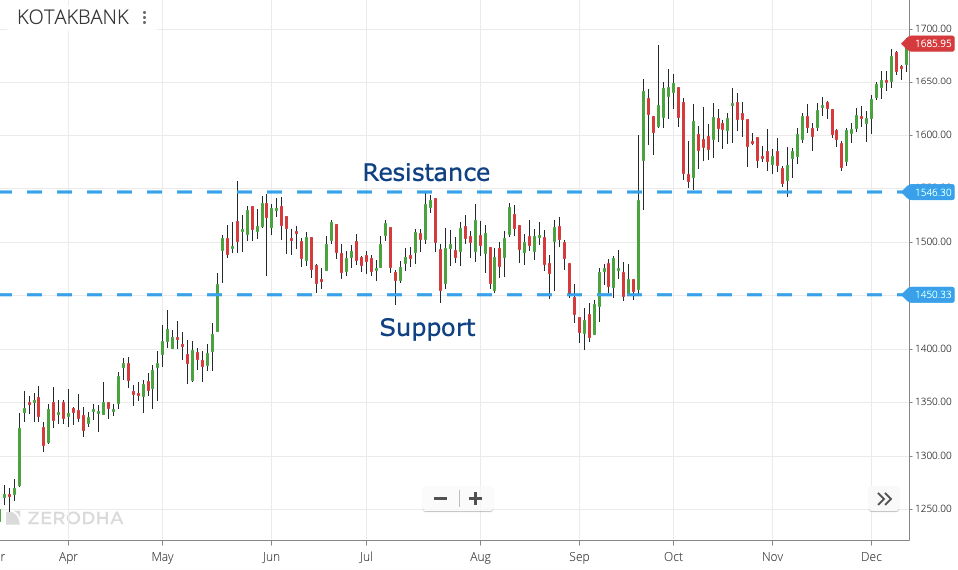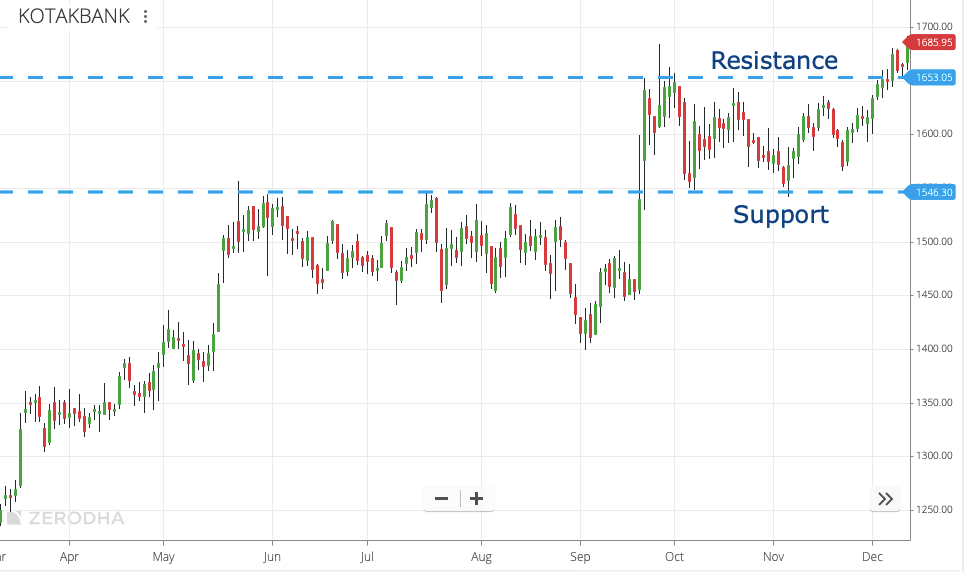Support and Resistance is one of the most effective indicators for traders to identify price points at which stocks can be bought or sold.
Let’s get straight to the chart and check out an example of Support and Resistance.

The above chart is of Kotak Bank. Notice how the stock frequently bounces between the price range of 1450 to 1550.
Over a period of 4 months between June and September 2019 – the support for the stock came at ₹ 1450, while resistance was at ₹ 1550 levels.
In other words, when the price got close to ₹ 1550, the demand (buyers) reduced and supply (sellers) increased. This resulted in a correction.
But as soon as the price came back to ₹ 1450 levels, the demand (buyers) increased and the supply (sellers) reduced – this resulted in the price going up again until it reached its resistance point of ₹ 1550.
The level of support and resistance also suggests that majority of market participants believe there is value in the stock at ₹ 1450 levels – due to which there are more buyers and fewer sellers.
It also suggests the stock is over-valued at ₹ 1550 – because as soon as the price gets to that price, there is selling pressure i.e more sellers and fewer buyers.
How traders use support and resistance levels
Once the support and resistance levels are confirmed, traders buy at support levels (Kotak Bank at ₹ 1450) and sell at resistance level (at ₹ 1550).
When the stock is bought at ₹ 1450, the stop loss is usually set below the support level. If the price of the stock falls between the support level, an important level is assumed to have been broken – which could lead to a further fall in price of the stock.
When the stock is sold at ₹ 1550, the stop loss is set above that price. If the stock rises above ₹ 1550, it’s considered to be a ‘breakout’ and traders expect the stock to rise further up.
In the Kotak Bank example above, notice how the stock went above its resistance level in Mid-September – when the price went above ₹ 1550.
When a stock goes above its resistance level, the resistance now becomes the new support.
The image below will give you a clearer idea:

In the chart above, ₹ 1550 was the resistance until Mid September. But once the stock went above that level (also called as ‘break out’), it reached new highs – but during the next correction, the stock found support at ₹ 1550 and the new resistance was now around the ₹ 1650 level.
This is how support and resistance works. When a level of support gets broken on the downside, it becomes the resistance. And when resistance level gets broken on the upside, it becomes the new support.
The chart of Kotak Bank for the last 7 months beautifully illustrates how support and resistance works.
False Break Down or Break Out
Sometimes a stock can go below its support level temporarily and recover quickly. This is called as ‘False Break Down’. This kind of move can sometimes be to trap those who bought at the support level.
In the first chart of Kotak Bank at the beginning of the article, notice how the stock price went below ₹ 1450 on one occasion in September and quickly rose back. Those who bought at ₹ 1450 levels with a stop loss below that price, would’ve probably sold out fearing a break-down in price. But the stock quickly recovered.
In such a scenario, experienced traders would strictly follow their stop losses with discipline and sell below ₹ 1450. But once the price rises back, confirming that it was a false ‘break down’, seasoned traders would buy again.
Do this:
Open a few charts on Zerodha, Upstox or any other charting software. Identity support and resistance levels of different stocks.
Draw horizontal lines for support and resistance. Do this for a few days, after which you can easily identity support and resistance levels.
After this, you could plan a few trades based on support and resistance levels. Buy stocks that are near their short or medium term support levels (Use 60 minute chart or Daily chart for this). You can also short sell stocks that are near their resistance levels and close your position at support level. Obviously, you need to have strict stop loss.

Leave a Comment